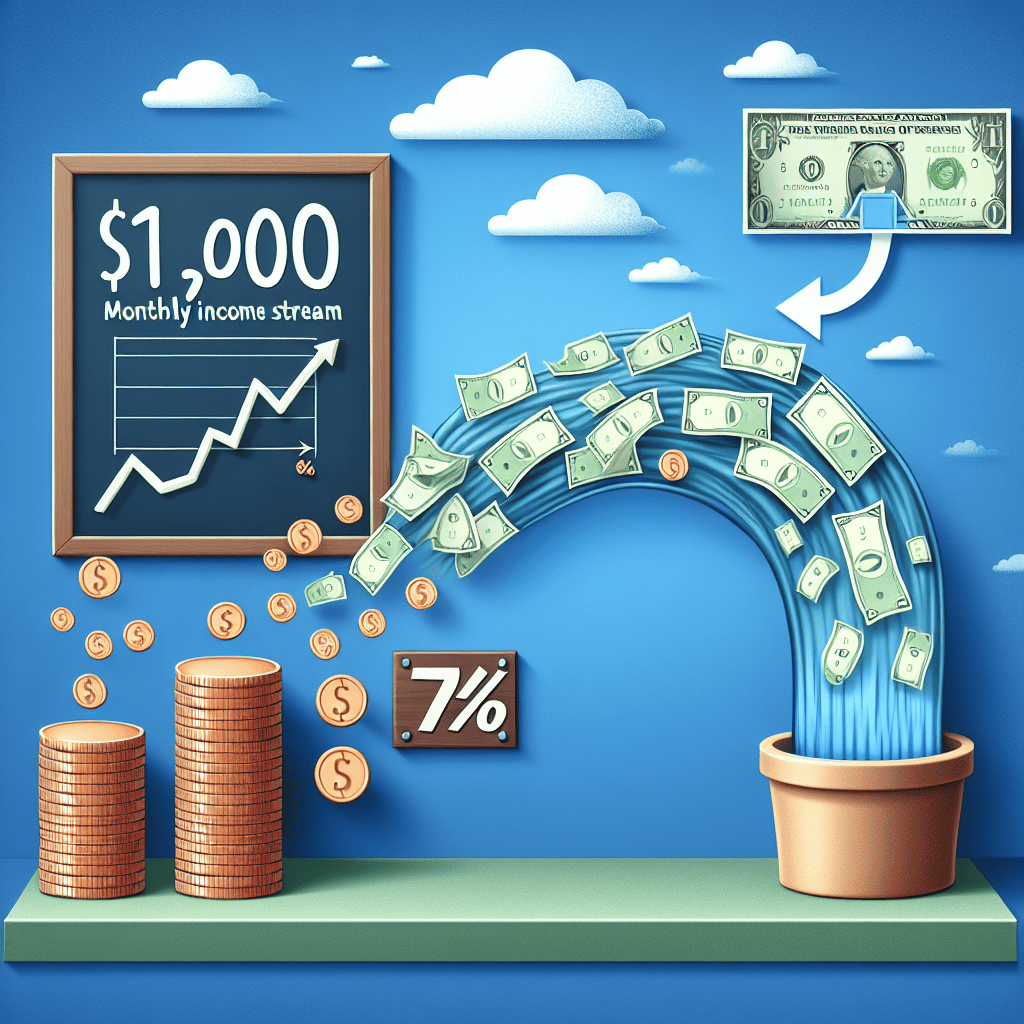“Unlock Steady Wealth: Turn $1,000 into Monthly Income with a 7% Dividend Powerhouse!”
Introduction
Investing in dividend stocks can be a powerful strategy for generating a steady stream of income, especially in today’s volatile market environment. By carefully selecting stocks with a strong track record of consistent dividend payments and growth, investors can potentially transform a modest initial investment into a lucrative monthly income. One such opportunity lies in a particular dividend stock offering a compelling 7% yield. With a disciplined approach and a focus on long-term growth, this investment can serve as a cornerstone for building a reliable income stream, turning an initial $1,000 investment into a significant source of monthly earnings.
Understanding Dividend Stocks: A Beginner’s Guide
Investing in dividend stocks can be a strategic way to generate a steady stream of income, especially for those new to the world of investing. Understanding the fundamentals of dividend stocks is crucial for beginners who wish to transform a modest investment into a lucrative monthly income. One such opportunity lies in a stock offering a 7% dividend yield, which can be particularly appealing for investors seeking regular income.
To begin with, dividend stocks are shares in companies that return a portion of their profits to shareholders in the form of dividends. These payments are typically made on a quarterly basis, although some companies may distribute them monthly or annually. The appeal of dividend stocks lies in their ability to provide investors with a reliable income stream, in addition to any potential capital appreciation from the stock itself. For beginners, this dual benefit can be an attractive proposition, as it offers both immediate returns and long-term growth potential.
When considering a dividend stock with a 7% yield, it is essential to understand the concept of dividend yield itself. The dividend yield is calculated by dividing the annual dividend payment by the stock’s current price. A 7% yield indicates that for every $100 invested, the investor can expect to receive $7 in dividends annually. This yield can be particularly enticing in a low-interest-rate environment, where traditional savings accounts and bonds may offer minimal returns.
However, it is important to approach high-yield dividend stocks with caution. While a 7% yield may seem attractive, it is crucial to assess the sustainability of the dividend. Companies offering high yields may be doing so because their stock price has fallen, potentially due to underlying business challenges. Therefore, conducting thorough research into the company’s financial health, earnings stability, and dividend history is imperative. A company with a consistent track record of paying and increasing dividends is generally a more reliable choice for income-focused investors.
Moreover, diversification is a key principle in investing, and this holds true for dividend stocks as well. Relying solely on one high-yield stock can expose an investor to significant risk if the company faces financial difficulties. Instead, building a diversified portfolio of dividend-paying stocks across various sectors can help mitigate risk and provide a more stable income stream. This approach not only spreads risk but also allows investors to benefit from different economic cycles and industry trends.
In addition to diversification, reinvesting dividends can further enhance the potential for income growth. By using dividends to purchase additional shares, investors can take advantage of compounding, which can significantly increase the value of their investment over time. This strategy can be particularly effective for those with a long-term investment horizon, as it allows the initial investment to grow exponentially.
In conclusion, transforming a $1,000 investment into a lucrative monthly income through a 7% dividend stock is an achievable goal for beginners who approach it with careful consideration and strategic planning. By understanding the fundamentals of dividend stocks, assessing the sustainability of high yields, diversifying their portfolio, and reinvesting dividends, investors can create a reliable income stream that complements their broader financial objectives. As with any investment, due diligence and a clear understanding of one’s risk tolerance are essential to making informed decisions that align with personal financial goals.
The Power of Compound Interest in Dividend Investing
Investing in dividend stocks has long been a favored strategy for those seeking to generate a steady stream of income. Among the myriad of options available, stocks offering a 7% dividend yield stand out as particularly attractive. By harnessing the power of compound interest, investors can transform an initial investment of $1,000 into a lucrative monthly income over time. This approach not only provides immediate financial benefits but also sets the stage for long-term wealth accumulation.
To begin with, the concept of compound interest is fundamental to understanding how dividend investing can be so effective. Unlike simple interest, which is calculated only on the principal amount, compound interest takes into account the interest on both the initial principal and the accumulated interest from previous periods. This means that over time, the growth of your investment accelerates, as you earn interest on an increasingly larger sum. In the context of dividend stocks, reinvesting dividends allows investors to purchase additional shares, thereby increasing the potential for future dividend payments.
Consider a stock with a 7% annual dividend yield. If an investor initially purchases $1,000 worth of this stock, they would receive $70 in dividends over the course of the first year. By reinvesting these dividends, the investor can buy more shares, which in turn generate additional dividends. This cycle of reinvestment and growth exemplifies the power of compound interest. Over time, even a modest initial investment can grow substantially, leading to a significant increase in monthly income.
Moreover, the benefits of this strategy are not limited to the dividends themselves. As the investor accumulates more shares, they also stand to benefit from any appreciation in the stock’s price. While dividend stocks are often chosen for their income potential rather than their growth prospects, many such stocks do experience price appreciation over time. This dual benefit of income and growth can further enhance the investor’s financial position.
It is important to note, however, that not all dividend stocks are created equal. Investors must carefully evaluate the sustainability of a company’s dividend payments. A high yield is attractive, but it is crucial to ensure that the company has a stable financial foundation and a history of consistent dividend payments. Additionally, diversification is key to managing risk. By spreading investments across multiple dividend-paying stocks, investors can mitigate the impact of any single company’s performance on their overall portfolio.
Furthermore, patience and discipline are essential components of a successful dividend investing strategy. The true power of compound interest is realized over the long term, and investors must be willing to reinvest dividends consistently and resist the temptation to cash out early. By maintaining a long-term perspective, investors can maximize the benefits of this approach and achieve their financial goals.
In conclusion, transforming a $1,000 investment into a lucrative monthly income through a 7% dividend stock is not only possible but also a prudent strategy for those seeking financial independence. By leveraging the power of compound interest, reinvesting dividends, and maintaining a diversified portfolio, investors can enjoy a steady stream of income while building wealth over time. This approach, grounded in patience and careful selection, offers a pathway to financial security and prosperity.
How to Identify High-Yield Dividend Stocks
Investing in high-yield dividend stocks can be a strategic way to generate a lucrative monthly income, especially when starting with a modest sum like $1,000. Identifying the right dividend stocks, however, requires a keen understanding of several key factors that can influence both the yield and the sustainability of the dividends. To begin with, it is essential to understand what constitutes a high-yield dividend stock. Typically, these are stocks that offer a dividend yield significantly higher than the average yield of the broader market. A 7% dividend yield, for instance, is considered attractive, especially in a low-interest-rate environment. However, a high yield alone does not guarantee a good investment. It is crucial to assess the sustainability of the dividend, which involves examining the company’s financial health and its ability to generate consistent cash flow.
One of the primary indicators of a company’s ability to sustain its dividend is the payout ratio, which measures the proportion of earnings paid out as dividends. A payout ratio that is too high may indicate that the company is overextending itself, potentially leading to dividend cuts in the future. Ideally, investors should look for companies with a payout ratio that is comfortably below 100%, suggesting that the company retains enough earnings to reinvest in its growth while still rewarding shareholders. Furthermore, examining the company’s historical dividend payments can provide insights into its commitment to returning value to shareholders. Companies with a track record of stable or increasing dividends are often more reliable, as they demonstrate a commitment to maintaining or growing their dividend payouts over time.
In addition to the payout ratio and dividend history, it is important to consider the company’s overall financial health. This involves analyzing key financial metrics such as revenue growth, profit margins, and debt levels. A company with strong revenue growth and healthy profit margins is more likely to sustain its dividend payments, even during economic downturns. Conversely, a company burdened with high levels of debt may struggle to maintain its dividend, as it may need to prioritize debt repayments over shareholder returns. Therefore, a thorough analysis of the company’s balance sheet and income statement is essential in assessing its financial stability.
Moreover, understanding the industry in which the company operates can provide additional context for evaluating its dividend sustainability. Some industries, such as utilities and consumer staples, are known for their stable cash flows and resilience during economic downturns, making them attractive for dividend investors. On the other hand, industries that are more cyclical or subject to rapid technological changes may pose higher risks to dividend sustainability. Therefore, investors should consider the broader industry trends and the company’s competitive position within its sector.
Finally, it is important to diversify one’s investment across multiple high-yield dividend stocks to mitigate risk. By spreading investments across different sectors and companies, investors can reduce the impact of any single company’s dividend cut on their overall income. In conclusion, while a 7% dividend yield can be an enticing prospect for generating a lucrative monthly income, it is imperative to conduct thorough research and analysis to identify high-yield dividend stocks that offer both attractive yields and sustainable payouts. By focusing on key financial metrics, industry trends, and diversification, investors can enhance their chances of achieving a reliable and growing income stream from their dividend investments.
Risk Management Strategies for Dividend Investors

Investing in dividend stocks can be a rewarding strategy for those seeking to generate a steady stream of income. However, like any investment, it comes with its own set of risks. For dividend investors, particularly those looking to transform a modest sum like $1,000 into a lucrative monthly income, understanding and implementing effective risk management strategies is crucial. By focusing on a 7% dividend stock, investors can potentially achieve their income goals, but they must also be vigilant in managing the associated risks.
To begin with, diversification is a fundamental risk management strategy that cannot be overstated. While the allure of a high-yield dividend stock is tempting, placing all your capital into a single stock can expose you to significant risk. Market volatility, company-specific issues, or changes in the economic environment can adversely affect the stock’s performance and, consequently, its dividend payouts. Therefore, it is prudent to diversify your investment across multiple dividend-paying stocks, ideally in different sectors. This approach helps mitigate the risk of a single stock’s underperformance impacting your overall income.
In addition to diversification, conducting thorough research and due diligence is essential. Before investing in a 7% dividend stock, investors should evaluate the company’s financial health, dividend history, and payout ratio. A company with a strong balance sheet, consistent dividend payments, and a sustainable payout ratio is more likely to maintain its dividend yield over time. Furthermore, understanding the company’s business model and industry trends can provide insights into its future growth prospects and ability to continue paying dividends.
Another critical aspect of risk management is monitoring interest rate trends. Dividend stocks often face pressure when interest rates rise, as investors may shift their focus to fixed-income securities that offer competitive yields. Consequently, it is important to stay informed about macroeconomic indicators and central bank policies that could influence interest rates. By doing so, investors can make informed decisions about whether to hold, sell, or adjust their dividend stock portfolio in response to changing market conditions.
Moreover, setting realistic expectations and maintaining a long-term perspective are vital components of a successful dividend investment strategy. While a 7% dividend yield is attractive, it is important to recognize that stock prices and dividend payouts can fluctuate. Investors should be prepared for periods of volatility and not be swayed by short-term market movements. By focusing on the long-term potential of their investments, dividend investors can better weather market fluctuations and remain committed to their income-generating goals.
Finally, reinvesting dividends can be an effective way to enhance returns and manage risk. By using dividends to purchase additional shares, investors can benefit from compounding, which can lead to increased income over time. This strategy not only helps grow the investment but also provides a buffer against potential declines in stock prices or dividend cuts.
In conclusion, while investing in a 7% dividend stock offers the potential to transform $1,000 into a lucrative monthly income, it is imperative for investors to employ robust risk management strategies. By diversifying their portfolio, conducting thorough research, monitoring interest rate trends, setting realistic expectations, and reinvesting dividends, investors can effectively manage risks and enhance their chances of achieving their income objectives. Through careful planning and disciplined execution, dividend investors can navigate the complexities of the market and enjoy the benefits of a steady income stream.
The Role of Dividend Reinvestment Plans (DRIPs)
Dividend Reinvestment Plans, commonly known as DRIPs, play a pivotal role in transforming a modest investment into a substantial source of income over time. For investors seeking to turn a $1,000 investment into a lucrative monthly income, particularly through a 7% dividend stock, understanding and utilizing DRIPs can be a game-changer. These plans allow investors to automatically reinvest their cash dividends into additional shares of the underlying stock, often without incurring brokerage fees. This reinvestment strategy not only amplifies the compounding effect but also enhances the potential for long-term wealth accumulation.
To begin with, the concept of compounding is central to the effectiveness of DRIPs. By reinvesting dividends, investors purchase more shares, which in turn generate more dividends. This cycle of reinvestment and growth can significantly increase the number of shares owned over time, thereby boosting the overall dividend income. For instance, with a 7% dividend yield, the reinvestment of dividends can lead to exponential growth in the number of shares held, as each dividend payment buys more shares, which then produce their own dividends. This compounding effect is particularly powerful over long periods, making DRIPs an attractive option for patient investors.
Moreover, DRIPs offer the advantage of dollar-cost averaging. By reinvesting dividends regularly, investors purchase shares at different price points, which can mitigate the impact of market volatility. This strategy ensures that investors buy more shares when prices are low and fewer when prices are high, potentially lowering the average cost per share over time. Consequently, this approach can enhance returns and reduce risk, making it a prudent strategy for those looking to build a steady income stream from dividends.
In addition to these benefits, DRIPs often come with the added advantage of purchasing shares at a discount. Some companies offer shares at a reduced price to participants in their DRIP, providing an immediate boost to the value of reinvested dividends. This discount can further enhance the compounding effect and accelerate the growth of the investment. For investors focused on maximizing their returns, this feature can be particularly appealing.
Furthermore, the use of DRIPs aligns well with a long-term investment strategy. By continuously reinvesting dividends, investors are encouraged to adopt a buy-and-hold approach, which can be beneficial in capturing the full potential of a 7% dividend stock. This long-term perspective not only allows for the accumulation of more shares but also provides the opportunity to benefit from potential capital appreciation of the stock itself. Over time, the combination of dividend income and capital gains can significantly enhance the overall return on investment.
In conclusion, Dividend Reinvestment Plans offer a powerful mechanism for transforming a $1,000 investment into a lucrative monthly income, especially when investing in a 7% dividend stock. Through the compounding effect, dollar-cost averaging, potential discounts, and alignment with long-term investment strategies, DRIPs provide a structured and effective way to build wealth. For investors willing to embrace patience and consistency, DRIPs can serve as a cornerstone in achieving financial goals and securing a steady income stream for the future.
Tax Implications of Dividend Income
When considering the transformation of a $1,000 investment into a lucrative monthly income through a 7% dividend stock, it is crucial to understand the tax implications associated with dividend income. Dividends, which are payments made by a corporation to its shareholders, can be an attractive source of income, especially when the dividend yield is as high as 7%. However, the tax treatment of these dividends can significantly impact the net income received by the investor.
To begin with, dividends are generally classified into two categories: qualified and non-qualified dividends. Qualified dividends are those that meet specific criteria set by the Internal Revenue Service (IRS) and are taxed at the lower capital gains tax rates, which range from 0% to 20% depending on the investor’s taxable income and filing status. In contrast, non-qualified dividends are taxed at the individual’s ordinary income tax rates, which can be as high as 37%. Therefore, understanding whether the dividends from a particular stock are qualified or non-qualified is essential for tax planning purposes.
Moreover, the holding period of the stock plays a significant role in determining the tax rate applicable to dividends. For dividends to be considered qualified, the investor must hold the stock for more than 60 days during the 121-day period that begins 60 days before the ex-dividend date. This requirement encourages long-term investment and can result in substantial tax savings for those who meet the criteria. Consequently, investors should be mindful of their holding periods to maximize the tax efficiency of their dividend income.
In addition to federal taxes, state taxes can also affect the net income from dividends. Each state has its own tax laws, and while some states do not tax dividend income, others may impose significant taxes. Therefore, investors should be aware of their state’s tax regulations and consider the impact on their overall dividend income strategy. This is particularly important for those who reside in states with high income tax rates, as the combined federal and state taxes can substantially reduce the effective yield of a dividend stock.
Furthermore, for investors who hold dividend-paying stocks in tax-advantaged accounts such as Individual Retirement Accounts (IRAs) or 401(k) plans, the tax implications differ. In these accounts, dividends are typically not taxed in the year they are received. Instead, taxes are deferred until the funds are withdrawn, potentially allowing for tax-free growth of the investment. This can be a strategic advantage for investors looking to maximize their dividend income over the long term.
Finally, it is important to consider the impact of dividend reinvestment plans (DRIPs) on tax liabilities. While reinvesting dividends can compound returns and increase future income, it does not exempt the investor from paying taxes on the dividends received. Each reinvested dividend is still subject to taxation in the year it is paid, which can complicate tax reporting and planning.
In conclusion, while a 7% dividend stock can indeed transform a $1,000 investment into a lucrative monthly income, understanding the tax implications is essential for maximizing net returns. By considering factors such as the classification of dividends, holding periods, state taxes, and the use of tax-advantaged accounts, investors can make informed decisions that enhance the overall profitability of their dividend income strategy.
Building a Diversified Portfolio with Dividend Stocks
Investing in dividend stocks is a strategic approach to building a diversified portfolio that not only appreciates over time but also generates a steady stream of income. For investors seeking to transform a modest sum, such as $1,000, into a lucrative monthly income, focusing on stocks with a reliable dividend yield is essential. A 7% dividend stock, in particular, can serve as a cornerstone of this strategy, offering both growth potential and regular income.
To begin with, dividend stocks are shares in companies that distribute a portion of their earnings to shareholders in the form of dividends. These payments can provide a consistent income stream, which is particularly appealing in volatile markets where capital gains may be uncertain. By reinvesting dividends, investors can also benefit from compounding returns, further enhancing their portfolio’s growth over time. However, it is crucial to select stocks with sustainable dividend yields, as excessively high yields may indicate underlying financial instability.
A 7% dividend yield is considered attractive, especially in a low-interest-rate environment where traditional savings accounts and bonds offer minimal returns. Investing $1,000 in a stock with such a yield can generate approximately $70 annually in dividends. While this may seem modest initially, the power of compounding and strategic reinvestment can significantly amplify returns over the long term. Moreover, by diversifying across multiple dividend stocks, investors can mitigate risks associated with individual companies and sectors.
When building a diversified portfolio, it is important to consider the financial health and dividend history of potential investments. Companies with a track record of stable or increasing dividends are generally more reliable, as they demonstrate a commitment to returning value to shareholders. Additionally, evaluating the payout ratio, which measures the proportion of earnings paid out as dividends, can provide insights into the sustainability of the dividend. A lower payout ratio suggests that the company retains sufficient earnings to reinvest in growth, while still rewarding shareholders.
Furthermore, diversification across different industries and geographies can enhance the resilience of a dividend portfolio. By investing in a mix of sectors such as utilities, consumer goods, and healthcare, investors can reduce exposure to sector-specific risks. Similarly, including international dividend stocks can provide access to growth opportunities in emerging markets and hedge against domestic economic fluctuations.
In addition to selecting individual stocks, investors may also consider dividend-focused exchange-traded funds (ETFs) or mutual funds. These investment vehicles offer instant diversification and professional management, making them an attractive option for those who prefer a hands-off approach. However, it is important to be mindful of management fees, which can erode returns over time.
In conclusion, transforming $1,000 into a lucrative monthly income through dividend stocks requires careful selection and strategic diversification. By focusing on stocks with a sustainable 7% yield and reinvesting dividends, investors can build a portfolio that not only generates regular income but also appreciates over time. While the journey requires patience and diligence, the rewards of a well-constructed dividend portfolio can be substantial, providing financial security and peace of mind.
Q&A
1. **What is the stock?**
– The stock is typically a high-yield dividend stock, often from sectors like utilities, real estate investment trusts (REITs), or business development companies (BDCs).
2. **What is the dividend yield?**
– The dividend yield is 7%.
3. **How much income can $1,000 generate annually with this stock?**
– $1,000 invested at a 7% yield generates $70 annually.
4. **How much income can $1,000 generate monthly with this stock?**
– $1,000 invested at a 7% yield generates approximately $5.83 monthly.
5. **What are the risks associated with high dividend stocks?**
– Risks include potential dividend cuts, stock price volatility, and sector-specific risks.
6. **What should investors consider before investing in high dividend stocks?**
– Investors should consider the company’s financial health, dividend sustainability, and market conditions.
7. **How can reinvesting dividends impact returns?**
– Reinvesting dividends can compound returns over time, increasing the overall investment value and future income.
Conclusion
Investing $1,000 in a dividend stock with a 7% annual yield can generate a monthly income of approximately $5.83. While this amount may seem modest, reinvesting dividends and adding more capital over time can significantly enhance returns through the power of compounding. Additionally, selecting a reliable company with a strong track record of maintaining or increasing dividends can provide a stable and potentially growing income stream. However, investors should also consider the risks associated with dividend stocks, such as market volatility and the potential for dividend cuts, and ensure their investment aligns with their financial goals and risk tolerance.





